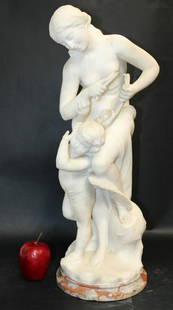
Grand Tour Bronze Nile River God Statue after Francesco Righetti
Similar Sale History
View More Items in Statues & StatuettesRelated Statues & Statuettes
More Items in Italian Statues & Statuettes
View More
Recommended Sculptures & Carvings
View More













Item Details
Description
Dimensions are 10.5" x 5.5"“The Colossus of the Nile" attributed to the workshop of Francesco Righetti (the elder) (Italian, 1738- 1819) An after the antique tour de force bronze sculpture. The bronze sculpture is meticulously cast and detailed. There are sixteen individual children "several which are cast separately and attached, (all with distinctly different facial expressions) that adorn the Colossus of the Nile. Gilding is typical of Francesco Righetti's workshop examples and the original gilding on this example is absolutely spectacular! The execution of this bronze required a very high degree of hand finishing. Francesco Righetti (apart from being well known for his foundry in Rome) was also a very accomplished sculptor who had been taught by the leading silversmith in Rome, Luigi Valadier (Italian, 1726-1785). Righetti quickly became Valadier's successor in producing faithful replicas of celebrated statues, both ancient and modern. Righetti sometimes collaborated with other artists in the sculpting of these models. A 1785 entry in the diary of Vincenzo Pacetti mentions that, Camillo ( his brother) was making "alcune copie per Righetti il Metallaro"( several copies for Righetti in metal). Camillo Pacetti (Rome, 2 May 1758 - Milan, 6 July 1826) copied antiquities in Righetti's workshop in 1785. Righetti was not the only artist to offer miniature versions - his rivals Giacomo and Giovanni Zoffoli produced similar versions in their slightly less expensive line of statuettes. During the 1785 Righetti acquired the Zoffoli bronze foundry ( thus removing his main competitor of cast bronze sculpture). Part of James Harper's, "Art in Rome in the Eighteenth Century (2000), pp. 276-277 " writes that In 1794 Righetti published a catalogue-style price list of the miniature statues available from his workshop, a document that attests both to the scope of his production and to his promotional talent. The offerings included seventy-eight single figures, twenty-five figure groups, forty-six busts, and various vases, trophies, and animal sculptures. Although most of the advertised bronzes were after noted antiquities, the catalogue also lists copies of modern works, including four statuettes after Bernini and five after Giambologna.The present bronze is after the reconstructed marble by Gaspare Sibilla ( Italian 1723-1782) for Pope Clement XIV; using drawings as references and his own imagination. This marble sculpture is currently the centerpiece of the Braccio Nouvo (new wing of the Vatican) – It is considered a Roman sculpture from the 1st century A.D. but is likely after an Hellenistic sculpture. Gaspare Sibilla was the sculptor to the Vatican -- who also created sculpture for church monuments such as the Monument to Benedict XIV in St. Peter's Cathedral and the monument to Cardinal Niccolò Antonelli in San Giovanni in Laterano. Sibilla was considered the chief restorer of the collection of antiquities in the Vatican. This marble sculpture was discovered in the sixteenth century in Rome under the church of "Santa Maria Sopra Minerva". The first recorded description of the sculpture was in 1523 and it was originally part of a fountain in the Belvedere statue court facing the river Tiber. An example similar in size to the present bronze sculpture was created in ceramic biscuit by Giovanni Volpato (Italian, 1735 Bassano del Grappa - 1803, Rome). This ceramic sculpture is part of the collection at the Metropolitan Museum of Art (A link to their web page is included below.) It should be noted that the floral and wave like details on the present bronze sculpture are faithful to the original Vatican marble sculpture and differ from the Metropolitan Museum /Volpato example mentioned previously. Volpato started his artistic life as an engraver who was initially taught by his mother. He also studied with the Remondini family (pre-eminent printers from the 17th to the 19th centuries). In his early twenties Volpato lived in Venice and worked under Francesco Bartolozzi. He moved to Rome in 1771 and found great success there creating engravings from Raphael’s paintings. Volpato’s oeuvre of engravings can be divided into three categories: architectural, topographical and humorous scenes from daily life. Volpato was both an archaeologist and a dealer in antiquities.In 1785 he opened a factory creating white glazed earthenware sculptures and introducing the art of hard paste biscuit china to the city of Rome. He employed over 20 modelers on the Via Pudenziana creating sculptures for the Grand Tour visitors. The Volpato factory created a less expensive alternative to the bronze sculptures by the Francesco Righetti (1738- 1819) and Giacomo and Giovanni Zoffoli (1738-1795 & (1745-1805) foundries in Rome. After Volpato's death in 1803 the ceramic factory was run by wife (who had remarried the chief modeler) and his son Guiseppe. The factory ceased production in 1831. The Wallace collection has a far less elaborate bronze of the Nile of similar dimension but without the 16 children (Illustrated on plate 45 of the 1931 catalogue) . References :The ancient Romans by Michael J. Vickers, University of Oxford Press 1992.Taste and the antique: the lure of classical sculpture, 1500-1900 By Francis Haskell, Nicholas Penny 1998Draper, James David. "The River Nile, a Giovanni Volpato Masterwork." Metropolitan Museum Journal, Vol. 37 (2002).James Harper, from Art in Rome in the Eighteenth Century (2000), cat. 147, p. 277.Hugh Honour,Neo-classicism 1968 Penguin.Hiesinger, Ulrich W. and Ann Percy. A Scholar Collects: Selections from the Anthony Morris Clark Bequest. Philadelphia: Phildelphia Museum of Art, 1980, p.126.The Wallace Collection Catalogues .Sculpture By J.G. Mann 1931.
Buyer's Premium
- 25% up to $50,000.00
- 20% up to $100,000.00
- 15% above $100,000.00
Grand Tour Bronze Nile River God Statue after Francesco Righetti
Estimate $6,500 - $10,500
18 bidders are watching this item.
Get approved to bid.
Shipping & Pickup Options
Item located in Los Angeles, CA, usSee Policy for Shipping
Local Pickup Available
Payment
Accepts seamless payments through LiveAuctioneers

TOP










































































